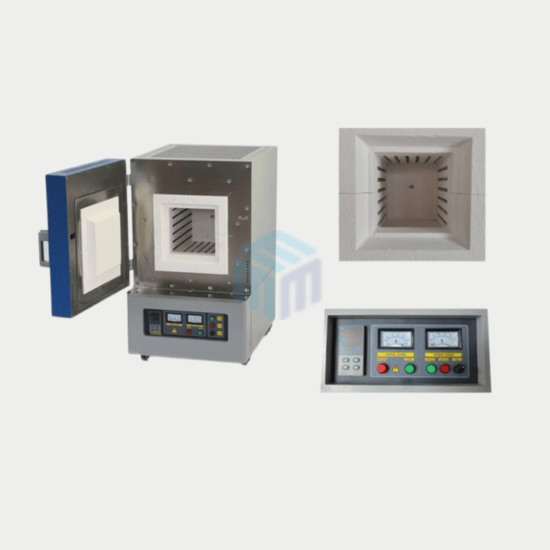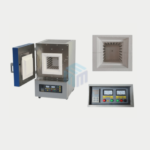When it comes to high-temperature heating solutions, understanding the difference between industrial furnaces and laboratory furnaces is essential for selecting the right equipment. Though they share similar principles, these furnaces vary significantly in terms of size, functionality, temperature range, and application. In this blog, we’ll break down the key distinctions between industrial and lab furnaces to help you determine which type best suits your operational or research needs.
-
Industrial Furnaces
Industrial furnaces are designed for large-scale applications and typically operate at higher temperatures to process metals, glass, ceramics, and other materials. They are robust, high-capacity, and optimized for continuous, high-demand production environments.
Types of Industrial Furnaces
When selecting an industrial furnace, understanding the different types available is essential. Each type is engineered for specific processes, temperature ranges, and energy sources. Here’s a breakdown of the most common types of industrial furnaces used across industries, these are:
Blast Furnace
A blast furnace is a high-temperature industrial unit primarily used for extracting metals like iron from their ores. It operates by blasting hot air into a mixture of ore, coke, and limestone, producing molten metal and slag. This type of furnace is crucial in large-scale metal production.
- Application: Primarily used in the steel industry for smelting iron ore into molten iron.
- Size and Capacity: Capacities can exceed 1,000 tons of molten iron per day.
- Temperature Range: Up to 2,200°C (3,992°F).
- Benefits: Efficient for large-scale metal production.
- Limitations: High energy consumption, environmental impact due to carbon emissions.
Induction Furnace
An induction furnace uses electromagnetic induction to generate heat, making it ideal for melting and alloying metals with high precision. It offers clean, energy-efficient, and controllable heating, commonly used in foundries and laboratories for processing ferrous and non-ferrous metals.
- Application: Melting and refining metals like steel, copper, and aluminum.
- Temperature Range: 1,200°C to 1,600°C (2,192°F to 2,912°F).
- Size and Capacity: Typically ranges from 1 to 100 tons per batch, with larger systems for high-volume operations.
- Benefits: Precise temperature control, high efficiency, minimal emissions.
- Limitations: Requires specialized setup and significant electrical power.
Rotary Kiln Furnace
A rotary kiln furnace is a long, cylindrical, rotating device used to process materials at high temperatures in a continuous flow. It’s widely used in industries like cement, metallurgy, and chemical processing for calcining, sintering, or pyroprocessing materials with consistent heat distribution.
- Application: Used in cement, lime, and refractory manufacturing industries.
- Temperature Range: 1,000°C to 1,450°C (1,832°F to 2,642°F).
- Size and Capacity: Lengths can exceed 100 meters with capacities ranging from 50 to 1,000 tons per day.
- Benefits: Continuous processing, large capacity.
- Limitations: High fuel consumption, requires extensive maintenance.
Electric Arc Furnace
An Electric Arc Furnace (EAF) uses high-voltage electric arcs to melt and refine metals, primarily steel. Common in steel recycling facilities, EAFs offer flexibility, energy efficiency, and precise temperature control, making them ideal for producing high-quality alloyed steel in modern metalworking industries.
- Application: Melting scrap metal, primarily in the steel recycling industry.
- Temperature Range: 1,300°C to 1,800°C (2,372°F to 3,272°F).
- Size and Capacity: Can range from 5 to 400 tons per charge, depending on the size of the furnace.
- Benefits: Efficient for recycling, can reach high temperatures quickly.
- Limitations: High electricity consumption, potential for noise and dust pollution.
Annealing Furnace
An Annealing Furnace is designed to heat materials—typically metals or glass—to a specific temperature and then cool them at a controlled rate. This process relieves internal stresses, improves ductility, and refines the microstructure of the material. Annealing furnaces are commonly used in metallurgy, glassmaking, and ceramics manufacturing.
- Application: Softening metals or glass through heat treatment to improve workability.
- Temperature Range: 200°C to 1,100°C (392°F to 2,012°F).
- Size and Capacity: Often ranges from a few hundred to several tons, depending on the design.
- Benefits: Enhances material properties, prevents metal cracking.
- Limitations: Requires precise temperature control; often a slow process.
Read also: Maximizing Efficiency with Modern Laboratory Furnaces
-
Laboratory Furnaces
Laboratory furnaces are designed for small-scale testing, research, and material development in labs. They offer precise temperature control, safety features, and are compact for benchtop or small-space applications.
Types of Laboratory Furnaces
Laboratory furnaces come in a variety of designs to accommodate different research and testing needs. Each type is tailored to specific temperature ranges, heating elements, and operational purposes. Below are the common types of laboratory furnaces used in scientific and industrial labs.
Muffle Furnace
A muffle furnace is a high-temperature laboratory furnace with a heating chamber isolated from combustion byproducts or heating elements. It’s widely used for ashing, sintering, heat treatment, and material testing due to its ability to maintain precise temperature control in a clean environment.
- Application: Heating samples in ceramics, chemical, and metallurgical research.
- Size and Capacity: Typically has a volume of 1 to 5 liters, suitable for small sample sizes.
- Temperature Range: Up to 1,200°C (2,192°F).
- Benefits: Clean heat source, ideal for ashing and incineration.
- Limitations: Limited sample size, cannot be used for large-scale production.
Tube Furnace
A tube furnace is a specialized laboratory furnace designed with a cylindrical heating chamber, ideal for heating small samples or materials inside tubes. It offers uniform temperature distribution and precise control, making it perfect for research, material synthesis, and thermal processing applications.
- Application: Conducting thermal processing in a controlled atmosphere, often for material synthesis and oxidation.
- Temperature Range: 1,100°C to 1,800°C (2,012°F to 3,272°F).
- Size and Capacity: Usually has a tube length of 60 to 150 cm, with diameters ranging from 2 to 10 cm.
- Benefits: Excellent for creating precise, controlled environments.
- Limitations: Small capacity; requires careful handling of gases.
Ashing Furnace
An ashing furnace is used primarily in laboratories to combust organic materials and leave behind inorganic ash for analysis. It provides controlled high temperatures to ensure complete oxidation, making it essential for sample preparation in fields like environmental testing, food analysis, and materials science.
- Application: Determining the mineral content in food, fuel, and other organic materials by combusting the organic matter.
- Temperature Range: 600°C to 1,100°C (1,112°F to 2,012°F).
- Size and Capacity: Generally ranges from 1 to 3 liters, suitable for small sample analysis.
- Benefits: Accurately measures ash content, compact design for lab work.
- Limitations: Limited to small samples; only suitable for specific applications.
Vacuum Furnace
A vacuum furnace operates in a controlled vacuum environment to prevent oxidation and contamination during heat treatment processes. It’s ideal for applications requiring precise temperature control and clean atmospheres, such as metal annealing, brazing, and sintering in advanced manufacturing and research.
- Application: Heat treatment in a vacuum environment, commonly used in metallurgy and material science research.
- Temperature Range: Up to 1,600°C (2,912°F).
- Size and Capacity: Typically designed for small batches, with chamber sizes from 10 to 100 liters.
- Benefits: Eliminates oxidation, ideal for sensitive materials.
- Limitations: Expensive, requires maintenance and special equipment to handle the vacuum.
Chamber Furnace
A chamber furnace features a spacious enclosed heating area designed for uniform temperature distribution. It’s commonly used for heat treatment, drying, and curing processes in laboratories and industrial settings where consistent heating of samples or parts is essential.
- Application: General-purpose lab furnace for heating, aging, or sterilizing samples.
- Temperature Range: 100°C to 1,200°C (212°F to 2,192°F).
- Size and Capacity: Usually has a capacity of 20 to 100 liters, allowing multiple samples.
- Benefits: Versatile; can handle multiple samples at once.
- Limitations: Limited to lower temperature ranges compared to other lab furnaces.
Read also: Choosing the Right Laboratory Furnace for Your Research
Conclusion:
In conclusion, industrial furnaces and laboratory furnaces serve distinct but equally important roles. Industrial furnaces are designed for large-scale, high-capacity operations with robust construction to handle continuous, heavy-duty use. In contrast, laboratory furnaces prioritize precision, control, and versatility for smaller-scale experiments and testing. Understanding the differences helps in selecting the right furnace type to meet specific operational needs efficiently and effectively.






